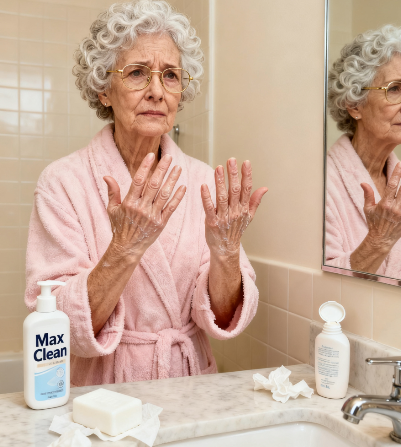
Using This Kind of Soap on Your Hands Too Often Can Dry Out Your…
You’ve done it thousands of times: a quick pump of hand soap, a brisk lather under warm water, and a rinse. It’s a fundamental habit of cleanliness, one we’ve all practiced diligently, especially in recent years. But what if the very product you’re using to keep your hands clean and healthy is secretly sabotaging the skin you’re trying to protect?
For those of us in our 50s, 60s, and beyond, our skin is already facing new challenges. It’s producing less natural oil, becoming thinner, and losing some of its ability to retain moisture. This makes it more vulnerable to irritation. And one of the most common culprits of this irritation is sitting right next to your sink: antibacterial or strong, harsh deodorant soaps.
While these soaps are effective at killing germs, their frequent use can strip away your skin’s natural defenses, leading to a problem far more uncomfortable than just temporary dryness. It can lead to chronic, painful cracking and damage to your skin’s protective barrier.
The Problem with “Getting Really Clean”
The intention is good. We want to eliminate bacteria and viruses. However, many popular antibacterial and deep-cleansing soaps achieve this through harsh detergents and chemicals like triclosan (though now less common) or high concentrations of alcohol. These ingredients are exceptionally effective—but they don’t discriminate. They wipe out bad germs and good, natural skin bacteria alike, while also stripping away your skin’s delicate acid mantle and natural lipids.
Think of your skin’s surface as a brick wall. The skin cells are the bricks, and a layer of oils and lipids is the mortar that holds everything together and keeps moisture in. Harsh soaps are like a powerful power washer that blasts away the mortar. The result?
- The bricks dry out and shrink, creating tiny cracks.
- Moisture escapes easily, leading to persistent dryness.
- Irritants can get in, causing itching, redness, and inflammation.
For mature skin that already has less “mortar,” this assault is particularly damaging. The dryness isn’t just a cosmetic issue; it’s a health one. Severely dry, cracked skin is more susceptible to infections, as tiny fissures provide an entry point for bacteria.
The Itch-Scratch Cycle: A Downward Spiral
This is where the real trouble begins. As the skin becomes dry and itchy, the natural response is to scratch. But scratching further damages the already compromised skin barrier, leading to more inflammation and itching—a vicious cycle known as the “itch-scratch cycle.” This can result in a condition called asteatotic eczema (or eczema craquelé), where the skin develops a network of fine, painful cracks, resembling a dry riverbed. This is especially common on the shins and hands of older adults.
A Gentler, Smarter Approach to Hand Hygiene
The goal isn’t to wash your hands less—it’s to wash them smarter. You can be clean and gentle at the same time.
1. Switch to a Gentle, Fragrance-Free Cleanser.
Look for soaps labeled as:
- “Syndet” Bars (Synthetic Detergent): These are technically not soaps but milder cleansing bars with a pH that is closer to that of healthy skin. Brands like Dove Sensitive Skin or Cetaphil are excellent examples.
- Cream-Based Liquid Soaps: These are often formulated with added moisturizers like glycerin or ceramides that help cleanse without stripping the skin.
- Fragrance-Free: Fragrances are a common irritant. Choosing a fragrance-free option reduces the risk of allergic reactions and further irritation.
2. Moisturize Immediately After Washing.
This is the most critical step. Within three minutes of washing and drying your hands, apply a generous amount of a good-quality moisturizer. This is the “golden window” when your damp skin can best absorb the moisturizer, helping to seal in water and replenish the lipids you just washed away. Keep a bottle of hand cream next to every sink in your house.
3. Choose the Right Moisturizer.
For very dry, mature skin, thicker, ointment-based creams are more effective than thin, watery lotions. Look for ingredients like:
- Petroleum Jelly: The gold standard for sealing in moisture.
- Ceramides: These are the lipids that naturally make up your skin barrier. Replenishing them directly helps repair the damage.
- Dimethicone: A silicone-based ingredient that forms a protective barrier on the skin.
4. Use Warm, Not Hot, Water.
Hot water is incredibly effective at dissolving and washing away your skin’s natural oils. Washing with comfortably warm water is just as effective for cleaning and is far gentler on your skin.
Clean hands are essential for good health, but they shouldn’t come at the cost of painful, cracked skin. By making a simple switch to a gentler soap and committing to immediate moisturizing, you can protect your body’s first line of defense. It’s a small change that allows you to maintain both cleanliness and comfort, ensuring your hands stay healthy, functional, and pain-free for all the things you love to do.